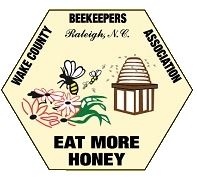 | Wake County Beekeepers Association |
Beekeeping Calendar
The Bees
| January |
Thousands of workers, tight winter cluster, little activity. Cleansing flights on a warm day (45°-50°). Queen begins to lay late December (after winter solstice) Some worker brood will begin to appear this month. Few if any drones present. |
| February |
Queen increases laying, few drones. Workers take cleansing flights on warm days. Bees consume about 25 pounds of food (combined stores and maple nectar). |
| March |
Days becoming longer, the queen steadily increases her rate of egg laying. More brood means more food will be consumed. Many drones may begin to appear. Populations are becoming high in preparation for coming nectar flow, but food stores can run dangerously low until the flow starts. First of package bees arrive. Any nucs offered for sale are almost all being raised in Florida or south Georgia. |
| April |
Early blossoms appear with improved weather. Bees continue to bring in pollen. Laying accelerates, population growing fast. More package bees available First of locally produced nucs and queens available. |
| May |
Hives are very active, nectar and pollen should begin to come into the hive thick and fast. This is the peak of the egg laying season for the queen. The hive should be bursting with busy buzzing bees. Watch orientation flights regularly to gage population increases (lawn chair optional). Local nucs and Queens available. |
| June |
Hives that haven't swarmed will be boiling with bees. The queen’s rate of egg laying may drop a little bit late this month when nectar dearth begins. Bee spring is over. Local nucs and Queens available. |
| July |
Bees will begin to hang around outside the hive (wash-boarding) The outside activity is beginning to slow down as the nectar flow decreases. Bee population begins to decline |
| August |
The colony’s population continues to drop. Drones are still around, but the workers will soon lose interest in feeding them. The outside activity is beginning to slow down until fall nectar flow begins. Bees may behave badly, become defensive. Weaker colonies may get robbed Bearding bees are good (strong colony) |
| September |
The hive population is dropping. The queen’s egg laying is significantly reduced, and the drones may begin to disappear this month. |
| October |
Not much activity going on in the hive now. The bees are settling down for the winter. Drones being expelled. If you use double deeps the cluster will move up, closer to honey stores/ |
| November |
Cold weather will send the bees into a cluster. |
| December |
The bees are in a tight cluster now. Queen may begin laying after winter solstice |
